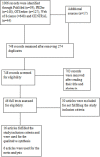Effects of Lower Limb Constraint Induced Movement Therapy in People With Stroke: A Systematic Review and Meta-Analysis
- PMID: 33833730
- PMCID: PMC8021771
- DOI: 10.3389/fneur.2021.638904
Effects of Lower Limb Constraint Induced Movement Therapy in People With Stroke: A Systematic Review and Meta-Analysis
Abstract
Background: Constraint induced movement therapy (CIMT) is effective at improving upper limb outcomes after stroke. Aim: The aim of this study was to carry out a systematic review and meta-analysis of the effects of lower limb CIMT studies of any design in people with stroke. Materials/ Method: PubMED, PEDro, OTSeeker, CENTRAL, and Web of Science were searched from their earliest dates to February 2021. Lower limbs CIMT studies that measured outcomes at baseline and post-intervention were selected. Sample size, mean, and standard deviation on the outcomes of interest and the protocols of both the experimental and control groups were extracted. McMaster Critical Review Form was used to assess the methodological quality of the studies. Result: Sixteen studies with different designs were included in this review. The result showed that lower limb CIMT improves functional, physiological and person's reported outcomes including motor function, balance, mobility, gait speed, oxygen uptake, exertion before and after commencement of activities, knee extensor spasticity, weight bearing, lower limb kinematics and quality of life in people with stroke post intervention. However, there were only significant differences in quality of life in favor of CIMT post-intervention [mean difference (MD) = 16.20, 95% CI = 3.30-29.10, p = 0.01]; and at follow-up [mean difference (MD) = 14.10, 95% CI = 2.07-26.13, p = 0.02] between CIMT and the control group. Even for the quality of life, there was significant heterogeneity in the studies post intervention (I 2 = 84%, p = 0.01). Conclusion: Lower limb CIMT improves motor function, balance, functional mobility, gait speed, oxygen uptake, weigh bearing, lower limb kinematics, and quality of life. However, it is only superior to the control at improving quality of life after stroke based on the current literature.
Keywords: activities of daily living; constraint induced movement therapy; lower extremity; quality of life; stroke.
Copyright © 2021 Abdullahi, Truijen, Umar, Useh, Egwuonwu, Van Criekinge and Saeys.
Conflict of interest statement
The authors declare that the research was conducted in the absence of any commercial or financial relationships that could be construed as a potential conflict of interest.
Figures







Similar articles
-
Influence of the constraint-induced method of constraint-induced movement therapy on improving lower limb outcomes after stroke: A meta-analysis review.Front Neurol. 2023 Mar 16;14:1090808. doi: 10.3389/fneur.2023.1090808. eCollection 2023. Front Neurol. 2023. PMID: 37006479 Free PMC article.
-
Effect of constraint-induced movement therapy on lower extremity motor dysfunction in post-stroke patients: A systematic review and meta-analysis.Front Neurol. 2022 Nov 21;13:1028206. doi: 10.3389/fneur.2022.1028206. eCollection 2022. Front Neurol. 2022. PMID: 36479056 Free PMC article.
-
Effects of constraint induced movement therapy in patients with multiple sclerosis: A systematic review.Mult Scler Relat Disord. 2023 Mar;71:104569. doi: 10.1016/j.msard.2023.104569. Epub 2023 Feb 17. Mult Scler Relat Disord. 2023. PMID: 36848838
-
Effect of constraint-induced movement therapy on persons-reported outcomes of health status after stroke: a systematic review and meta-analysis.Int J Rehabil Res. 2021 Mar 1;44(1):15-23. doi: 10.1097/MRR.0000000000000446. Int J Rehabil Res. 2021. PMID: 33234842
-
Effectiveness of Constraint-Induced Movement Therapy (CIMT) on Balance and Functional Mobility in the Stroke Population: A Systematic Review and Meta-Analysis.Healthcare (Basel). 2022 Mar 8;10(3):495. doi: 10.3390/healthcare10030495. Healthcare (Basel). 2022. PMID: 35326973 Free PMC article. Review.
Cited by
-
Effect of constraint-induced movement therapy combined with neuromuscular electrical stimulation on upper extremity function in stroke survivors: A protocol for systematic review.Medicine (Baltimore). 2023 Jul 14;102(28):e34249. doi: 10.1097/MD.0000000000034249. Medicine (Baltimore). 2023. PMID: 37443502 Free PMC article.
-
Lower-extremity constraint-induced movement therapy improved motor function, mobility, and walking after stroke.Eur J Phys Rehabil Med. 2023 Apr;59(2):136-144. doi: 10.23736/S1973-9087.23.07683-9. Epub 2023 Mar 9. Eur J Phys Rehabil Med. 2023. PMID: 36892520 Free PMC article.
-
Influence and significance of bilateral upper-extremity training on recovery of upper-extremity motor function for hemiplegic patients with mild-moderate cerebral apoplexy: a randomised controlled study.Afr Health Sci. 2022 Sep;22(3):375-382. doi: 10.4314/ahs.v22i3.40. Afr Health Sci. 2022. PMID: 36910402 Free PMC article. Clinical Trial.
-
Optimizing Rehabilitation Outcomes for Stroke Survivors: The Impact of Speed and Slope Adjustments in Anti-Gravity Treadmill Training.Medicina (Kaunas). 2024 Mar 27;60(4):542. doi: 10.3390/medicina60040542. Medicina (Kaunas). 2024. PMID: 38674188 Free PMC article.
-
Influence of the constraint-induced method of constraint-induced movement therapy on improving lower limb outcomes after stroke: A meta-analysis review.Front Neurol. 2023 Mar 16;14:1090808. doi: 10.3389/fneur.2023.1090808. eCollection 2023. Front Neurol. 2023. PMID: 37006479 Free PMC article.
References
-
- Cunningham DA, Varnerin N, Machado A, Bonnetta C, Janini D, Roelle S. Stimulation targeting higher motor areas in stroke rehabilitation: a proof-of-concept, randomized, double-blinded placebo-controlled study of effectiveness and underlying mechanisms. Restor Neurol Neurosci. (2015) 33:911–26. 10.3233/RNN-150574 - DOI - PMC - PubMed
Publication types
LinkOut - more resources
Full Text Sources
Other Literature Sources
Medical

